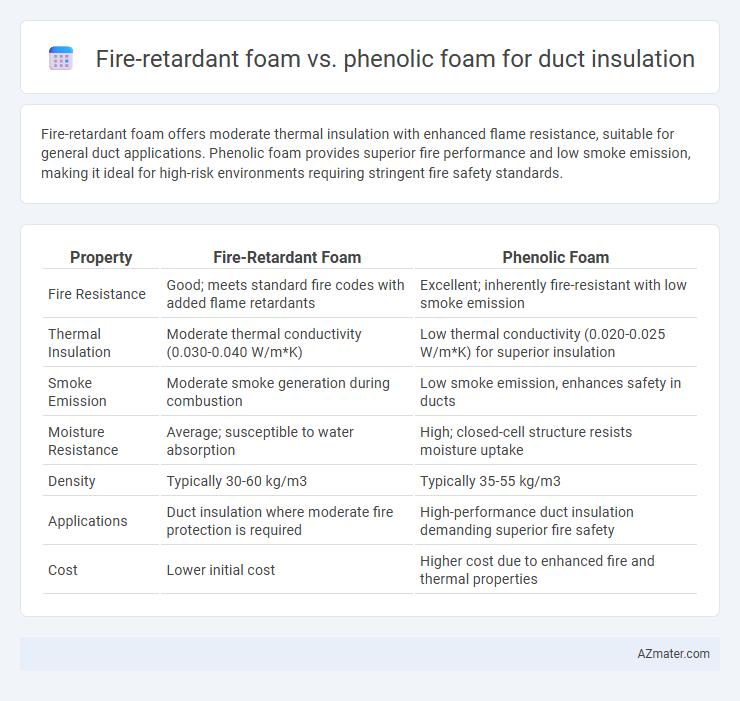Fire-retardant foam offers moderate thermal insulation with enhanced flame resistance, suitable for general duct applications. Phenolic foam provides superior fire performance and low smoke emission, making it ideal for high-risk environments requiring stringent fire safety standards.
Table of Comparison
| Property | Fire-Retardant Foam | Phenolic Foam |
|---|---|---|
| Fire Resistance | Good; meets standard fire codes with added flame retardants | Excellent; inherently fire-resistant with low smoke emission |
| Thermal Insulation | Moderate thermal conductivity (0.030-0.040 W/m*K) | Low thermal conductivity (0.020-0.025 W/m*K) for superior insulation |
| Smoke Emission | Moderate smoke generation during combustion | Low smoke emission, enhances safety in ducts |
| Moisture Resistance | Average; susceptible to water absorption | High; closed-cell structure resists moisture uptake |
| Density | Typically 30-60 kg/m3 | Typically 35-55 kg/m3 |
| Applications | Duct insulation where moderate fire protection is required | High-performance duct insulation demanding superior fire safety |
| Cost | Lower initial cost | Higher cost due to enhanced fire and thermal properties |
Introduction to Duct Insulation Materials
Fire-retardant foam and phenolic foam are widely used materials for duct insulation due to their thermal and fire-resistant properties. Fire-retardant foam provides effective heat resistance and flame retardancy, making it suitable for preventing fire spread in HVAC systems. Phenolic foam offers superior thermal insulation, low smoke emission, and excellent fire performance, making it a preferred choice for energy-efficient and safe duct insulation solutions.
Understanding Fire-Retardant Foam
Fire-retardant foam for duct insulation is engineered to resist ignition and slow the spread of flames, enhancing overall fire safety in HVAC systems. Unlike phenolic foam, which offers intrinsic low smoke and flame characteristics due to its chemical structure, fire-retardant foam may incorporate additives to achieve similar performance while maintaining flexibility and ease of installation. Understanding fire-retardant foam properties, such as its thermal stability, smoke toxicity levels, and compliance with fire safety standards like ASTM E84, is crucial for selecting appropriate insulation materials in commercial and industrial duct applications.
Overview of Phenolic Foam
Phenolic foam is a high-performance insulation material commonly used for duct insulation due to its excellent fire-retardant properties and low smoke emission. Its closed-cell structure provides superior thermal resistance and moisture resistance compared to traditional fire-retardant foams, enhancing energy efficiency and durability in HVAC systems. Phenolic foam's inherent flame retardancy and low combustibility make it a preferred choice in applications demanding stringent fire safety standards.
Thermal Performance Comparison
Fire-retardant foam demonstrates superior thermal insulation properties in duct applications, maintaining consistent R-values at elevated temperatures compared to phenolic foam. Phenolic foam offers low thermal conductivity but tends to degrade in performance under prolonged heat exposure, reducing its effectiveness in high-temperature environments. Selecting fire-retardant foam enhances overall energy efficiency by providing better thermal resistance and durability in HVAC duct insulation.
Fire Resistance Properties
Fire-retardant foam for duct insulation offers moderate fire resistance by slowing the spread of flames and reducing smoke production, adhering to basic safety standards. Phenolic foam demonstrates superior fire resistance due to its inherently low flammability, excellent char formation, and low smoke emission, making it highly effective in preventing fire propagation. Its thermal stability at high temperatures ensures enhanced protection in duct systems exposed to extreme fire conditions.
Moisture and Chemical Resistance
Fire-retardant foam offers moderate moisture resistance but can be susceptible to chemical degradation over time, impacting its durability in harsh environments. Phenolic foam exhibits superior moisture resistance due to its closed-cell structure, preventing water absorption and reducing mold growth risks in duct insulation. Its enhanced chemical resistance ensures long-term stability against corrosive agents, making it ideal for industrial HVAC applications requiring robust insulation performance.
Installation and Handling Differences
Fire-retardant foam offers greater flexibility and ease during installation due to its lighter weight and simpler cutting characteristics compared to phenolic foam. Phenolic foam, while highly fire-resistant and possessing superior thermal insulation properties, is more rigid and brittle, requiring specialized tools and careful handling to prevent damage. The handling challenges of phenolic foam can increase installation time and labor costs, whereas fire-retardant foam typically enables quicker and more efficient duct insulation application.
Cost Considerations
Fire-retardant foam typically offers a lower upfront cost for duct insulation compared to phenolic foam, making it a budget-friendly option for large-scale projects. Phenolic foam, though more expensive initially, provides enhanced fire resistance and better thermal insulation performance, potentially reducing long-term energy costs and maintenance expenses. When assessing cost considerations, it is crucial to balance immediate budget constraints against the lifespan and safety benefits associated with phenolic foam.
Environmental Impact and Sustainability
Fire-retardant foam and phenolic foam differ significantly in environmental impact and sustainability for duct insulation; phenolic foam typically offers lower Global Warming Potential (GWP) and reduced smoke emission during combustion. Fire-retardant foam often contains halogenated compounds that can release toxic byproducts and contribute to ozone depletion, whereas phenolic foam is produced from formaldehyde-based resins with better thermal insulation properties and longer lifespan, reducing material waste. Selecting phenolic foam supports sustainability goals by minimizing ecological footprint through improved energy efficiency and less hazardous waste generation.
Choosing the Right Foam for Your Ductwork
Fire-retardant foam offers excellent resistance to ignition and slows flame spread, making it ideal for duct insulation in high-risk fire zones where regulatory compliance is critical. Phenolic foam provides superior thermal insulation and low smoke emissions, enhancing energy efficiency and safety in commercial HVAC systems. Selecting the right foam depends on balancing fire safety standards, thermal performance, and application-specific requirements to optimize ductwork longevity and occupant protection.

Infographic: Fire-retardant foam vs Phenolic foam for Duct insulation
 azmater.com
azmater.com